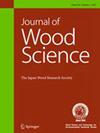氦辅助激光木材加工方法的研究
IF 2.4
3区 农林科学
Q2 FORESTRY
引用次数: 0
摘要
为了促进环保事业的发展,提高绿色能源的利用率,提出了一种采用氦辅助的先进、创新的激光加工方法,优化了相同能耗下的接头切割工艺。该方法为木材加工工业提供了新的思路。本文的独特之处在于建立了一个数学模型来解决氦注入扩散和激光束在加工表面的传热问题。结果表明,当在加工表面注入氦气时,氧浓度降低。氦气破坏了助燃条件,减小了加工接头切割的燃烧区。从而减少了加工表面的碳化面积,有效地提高了接头切割的加工质量。值得注意的是,随着喷射速度的增加,氦气在被加工表面形成一种扫射效应,可以去除被加工表面的部分碳化颗粒和残留物,提高加工质量。对比传统激光加工和氦辅助激光加工,气体辅助激光加工比传统激光加工和切割具有更高的加工质量。具有接头切割宽度小、表面粗糙度低、表面光滑等优点。最后,建立了以切口宽度、切口深度和表面粗糙度为评价标准的响应面法数学模型,分析了激光功率、切割速度和惰性气体压力对响应因子的影响。将预测值与实验测量值进行误差比较,得到优化后的工艺参数。本文提出的氦辅助激光加工方法不仅获得了较好的加工质量,而且为发展绿色工业提供了指导,具有一定的意义和意义。本文章由计算机程序翻译,如有差异,请以英文原文为准。
Research on the wood processing method of helium-assisted laser process
In order to promote the development of environmental protection, and the usage rate of green energy utilization, a progressive, innovative laser process method employing helium assisted is proposed, which optimizes the joint cutting process under the same energy consumption. This method provides a new idea for the wood process industry. The uniqueness of this paper establishes a mathematical model to address the diffusion of helium injection and the heat transfer of the laser beam on the processed surface. From the results, it can be exhibited that the oxygen concentration reduces when the helium is injected on the processed surface. The helium could destroy the combustion-supporting conditions and decrease the combustion zone of the processed joint cutting. Thus, the carbonized area of the processed surface is reduced, which could effectively enhance the processing quality of joint cutting. Notably, the helium with injection speed forms a sweeping effect on the processed surface, which could remove parts of the carbonized particles and residues on the processed surface, as well as improve the processing quality. Comparing the traditional laser process and helium-assisted laser process, the gas-assisted laser process owns higher process quality than that of traditional laser processing and cutting. In detail, it features the advantages of smaller joint cutting width, lower surface roughness and smoother surface. Eventually, a mathematical model based on the response surface method with the evaluation criteria of the kerf width, kerf depth, and surface roughness is established to analyze the interaction of laser power, cutting speed and inert gas pressure on the response factors. Comparing the error between the predicted and experimental measurement value, and the optimized process parameters could be acquired. In this paper, the helium-assisted laser process method proposed is meaningful and encouraging, which not only obtains better processing quality, but also provides a guide for developing green industry.
求助全文
通过发布文献求助,成功后即可免费获取论文全文。
去求助
来源期刊

Journal of Wood Science
工程技术-材料科学:纸与木材
CiteScore
5.40
自引率
10.30%
发文量
57
审稿时长
6 months
期刊介绍:
The Journal of Wood Science is the official journal of the Japan Wood Research Society. This journal provides an international forum for the exchange of knowledge and the discussion of current issues in wood and its utilization. The journal publishes original articles on basic and applied research dealing with the science, technology, and engineering of wood, wood components, wood and wood-based products, and wood constructions. Articles concerned with pulp and paper, fiber resources from non-woody plants, wood-inhabiting insects and fungi, wood biomass, and environmental and ecological issues in forest products are also included. In addition to original articles, the journal publishes review articles on selected topics concerning wood science and related fields. The editors welcome the submission of manuscripts from any country.
 求助内容:
求助内容: 应助结果提醒方式:
应助结果提醒方式:


